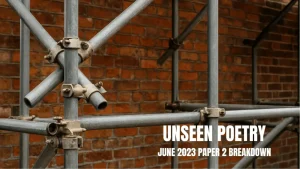How do the poets present the effects of power in My Last Duchess and Ozymandias?

In both ‘My Last Duchess’ by Robert Browning and ‘Ozymandias’ by Percy Bysshe Shelley, power is presented as a corrupting and ultimately transient force. Both poets use their work to critique how individuals abuse authority and explore the psychological and societal consequences of unchecked power. This essay will explore both the similarities and differences in how the poems present power as damaging, isolating, and inevitably undone by time or morality. Browning presents the sinister effects of personal power through a possessive Duke who controls and destroys, while Shelley explores the downfall of political power through the image of a ruined statue. Through dramatic monologue and sonnet forms, powerful imagery and tone, both poets suggest that those who wield power are dehumanised and forgotten, not glorified. Each poem also reflects its writer’s historical context: Browning critiques Victorian aristocracy and patriarchy, while Shelley, a Romantic radical, warns against authoritarian rule.
Browning’s ‘My Last Duchess’ presents the Duke as obsessed with control, especially over his late wife. The dramatic monologue allows readers intimate access to his manipulative mindset. Similarly, Shelley’s ‘Ozymandias’ presents a ruler consumed by pride and dominance, whose legacy is ironically reduced to ruin. In both poems, power isolates the speaker or subject, revealing how those in control often lose emotional connection and humanity. Each poet uses a central symbol—a portrait and a statue—to expose how powerful figures attempt to immortalise themselves, only to be undone by time. The Duke tries to preserve his wife’s image as an object, while Ozymandias’s statue lies in fragments, mocking his former glory. ……
Video Breakdown preview
The video analyzes a Level 6 and Level 4 response to the 2023 AQA Power and Conflict question: Compare how poets present the effects of power in My Last Duchess and one other poem. The exemplar uses Ozymandias for comparison.
Level 6 Response Summary:
-
-
Thesis: Power is corrupting, isolating, and ultimately transient.
-
Techniques: Sophisticated use of language, form, and structure (e.g. dramatic monologue, sonnet form, symbolic imagery).
-
Analysis: Detailed interpretation of characters’ psychology (Duke’s manipulation and Ozymandias’ arrogance), effects of time on power, and tone (irony, menace).
-
Comparison: Integrated and conceptual — not just similarities/differences but how both poets critique power through form and imagery.
-
Context: Relevant historical and social contexts are woven throughout (e.g. Romantic critique of tyranny, Victorian patriarchy).
-
Conclusion: Concise, restates argument, reflects on moral and historical erosion of power.
-
Level 4 Response Summary:
-
-
Shows basic understanding of themes and poetic devices.
-
Comparisons are valid but surface-level.
-
Analysis is mostly descriptive with limited insight into technique effects.
-
Context is mentioned but not explored in depth.
-
Lacks precision in explaining how form, structure, and language shape meaning.
-
 Alex Sharp is a seasoned English specialist with over a decade of experience teaching and examining GCSE English Literature and Language. As an AQA examiner, Alex has marked thousands of scripts, gaining deep insight into what examiners look for and...
Alex Sharp is a seasoned English specialist with over a decade of experience teaching and examining GCSE English Literature and Language. As an AQA examiner, Alex has marked thousands of scripts, gaining deep insight into what examiners look for and... 




